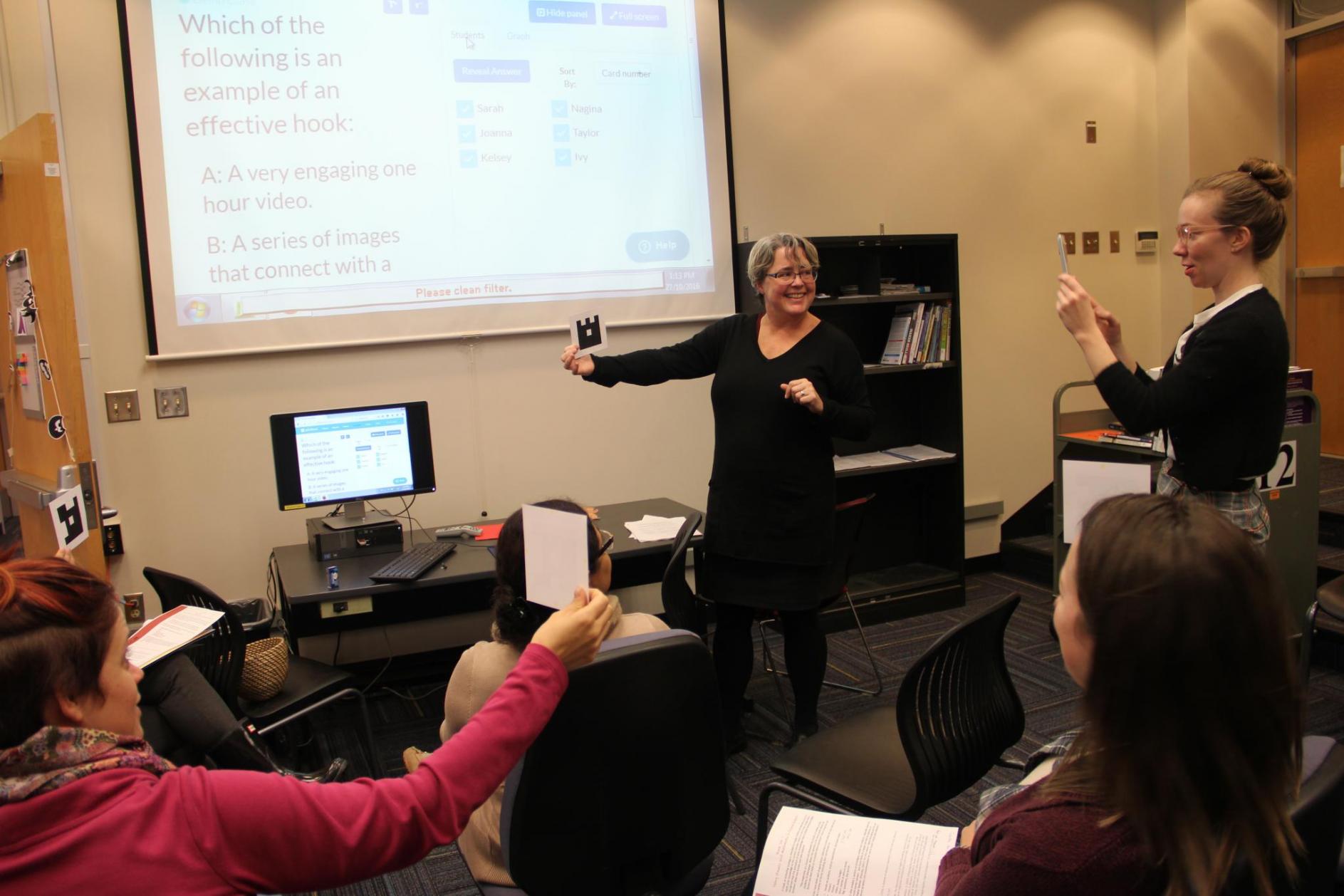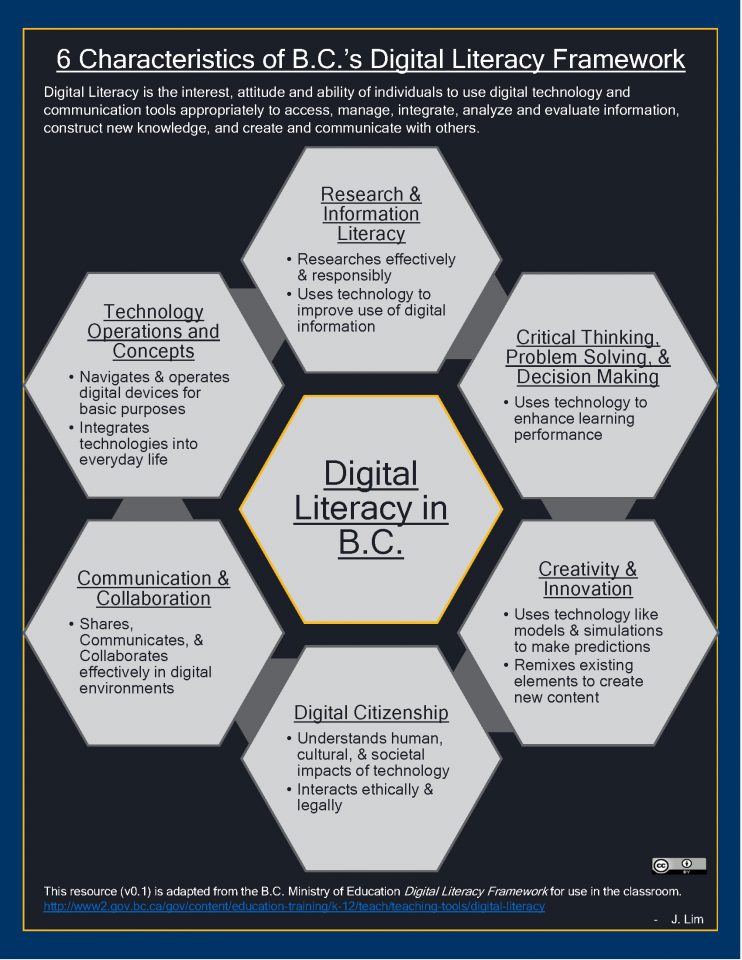I’ve had the opportunity to work with many of our on campus students here at UBC Vancouver to help them learn to effectively select a digital technology and appropriate teaching strategy. This week, I had the privilege of meeting with WKTP (West Kootenays Teacher Ed Program) candidates in Nelson via web conference to answer their questions and support them in selecting technologies to support teaching and learning. They are preparing their inquiry presentations and will be presenting using a digital gallery-style walk so are looking for unique ways to present.
Another important aspect of our conversation was to connect to their practicum planning and how they might effectively integrate digital technologies in their teaching contexts. Considering how their students might be supported through or with digital technologies has tremendous value in learning design. To this end, our session was framed around Universal Design for Learning (UDL) and the SAMR model by Ruben Puentedura. I also suggested to the TCs that when teachers consult the BC Digital Literacy Framework as part of planning for instruction, they will recognize that learning about, with and through digital technologies is an important part of teaching and learning in today’s classroom.
Here are some slides from our session: WKTP tech integration Slides Feb. 13, 2019
During the session, students experienced and viewed some examples of digital technology integration and were then provided with a little time to identify resources (in this blog or otherwise) that might support their learning and teaching objectives. We looked at several examples of how various presentation and creation tools might support sharing their inquiry and discussed how many of these same tools might provide excellent opportunities for their own students to develop presentations.
- Blogs to help develop and share inquiry.
- We’ve created some tutorial videos if you are using UBC Blogs and, as mentioned, if you decide to set up a UBC Blog, we can talk you through any difficulties you encounter. Please be in touch. In particular, you’ll want to consider privacy settings, blog design (use of pages/posts) and any interaction you’d like to incorporate (is it a static website or do you want active commenting and posting?)
- You will continue to have access as long as you have a CWL (so even as alumni).
- Canadian housed, secure server – FIPPA (freedom of information, privacy protection act) compliant.
- AR/VR including Thinglink, Google Tour Creator, Tour Builder. (Search the Scarfe Digital Sandbox Resources and filter by AR/VR.). Here is an example of an inquiry presentation by a UBC Van TC using Insta360 VR (shared with permission). NB: I am currently reluctant about VR with younger learners given the lack of research into the effects. If viewing 360 content, I recommend they do so on a browser or ipad vs. using ‘goggles’.
- Social Media platforms such as Twitter & Instagram. Here is an example of an inquiry presentation by a group of UBC Van TCs using Tumblr (shared with permission)
- Multimodal Creation – supportive of UDL (providing students with multiple means of representation and expression)
- SHOWME interactive whiteboard – I ask my students to ‘show me’ what they know about… to which they can draw, annotate, write, import images, narrate… There are other digital whiteboard apps available. Aww App is a browser based tool that is a little more limited but has some potential for classroom collaboration.
- Padlet another digital whiteboard that allows audio, text, hyperlinks and drawing – don’t forget to moderate your board if you use it in a classroom!! ;D and notice that commenting can be done without approval so you should consider carefully if you want to allow commenting.
- MindMapping has tremendous potential for supporting critical thinking and would make a unique inquiry presentation that a visitor could view and click on links to resources etc.
Next, we utilized the SAMR model to help evaluate the learning potential of digital resources. It is important to note that a model such as SAMR only has value if one considers the context (of the school, classroom, and child) in the selection and evaluation. For example, students viewed a video of a child who, without access to digital technologies, may not have been able to share the depth of her understanding. In this way, even a substitution approach might make all the difference for individual learning.
Additional resources and questions from our session:
- All-Student Response and Backchannel chat – providing adolescent learners anonymous opportunities to engage, voice their ideas, opinions, questions and understandings while providing teachers with the opportunity to gather data to inform teaching (and, potentially, strengthening or stretching student understanding). Remember, it is beneficial to incorporate discussion strategies (such as peer-teaching) when using all-student response.
- Plickers – a low tech to no tech response system with free downloadable cards and app. The teacher sets up a free account online and then ‘gathers’ responses by scanning the room with the plickers app on their device. The plickers app acts like a QR code scanner and gathers student responses. It was interesting to me that one TC suggested having students hold the card in front of their faces if there are concerns about plickers accessing the camera on your device. This reminds us that it is always important to be mindful of student privacy and what we decide to ‘trust’…
- Mentimeter (backchannel chat, all class response, polling etc). One TC remarked that once they accessed mentimeter, they were already receiving targeted ads – I haven’t found that this has impacted my own social media but, again, a good reminder about privacy and making decisions carefully about what you choose to bring into your classroom. Perhaps ensure location services are off for the app? other suggestions?

- Some tech tools and approaches shared by TCs via our ongoing discussion in our Mentimeter Backchannel
- Youtube in the Classroom? Remember to keep in mind that pop up ads can interrupt learning and influence learners in ways that may not be supportive. Try using the Quiettube extension, have an Adblock installed, or try Teachertube or ERAC and School District streaming resources such as Learn360 instead.
- Flipgrid – a US Application but read this Canadian Teacher’s alternative
- Youtube in the Classroom? Remember to keep in mind that pop up ads can interrupt learning and influence learners in ways that may not be supportive. Try using the Quiettube extension, have an Adblock installed, or try Teachertube or ERAC and School District streaming resources such as Learn360 instead.
- Responses to a few questions from our Backchannel Chat:
- Privacy and Inquiry sharing: if the inquiry is focused on you and doesn’t contain any reference to students or recognizable images of students, then you should be fine to share it online if that is something you (personally) are comfortable with. I actually recommend TCs do so when they can as this helps to begin to develop a professional presence online. You are searchable so having people actually find professional content about you can be valuable. NB: if your inquiry refers even generally to your observations on practicum that might in any way identify a school or students, I recommend removing such content. Happy to review and chat further about this. I taught the Inquiry course for several years…
- Remember also that you must have appropriate copyright permission for any content shared. I recommend doing a Creative Commons Image search and ensuring you attribute/reference appropriately. Further info in a blog post here.
- Issues of advertising and education: One student asked “How can we avoid the lamprey eels of advertising… with companies buying their way into schools”. I am glad TCs are asking these important questions. As we know, very little (if anything) is actually free. We need to be mindful of data privacy and advertising and how this can impact perception. I’m afraid I don’t have one answer for this question (that would make an excellent TC inquiry!) but can speak from my own experience. Perhaps even more importantly, we need to help our students become aware of the advertising they are continually bombarded with… they need to learn to ask critical questions and recognize the issues around consumerism/consumption. MediaSmarts is a non-profit project that provides some lessons & resources that you might consider incorporating into your teaching.
- Personally and professionally, I do not buy into the idea of promoting a specific company or product. When I share links to various resources on this site, I do so because I have (or one of my colleagues has) found them to have potential use in teaching and learning. We do some reviewing and testing and then provide a write up and links so that others might try them as well. Typically, these write ups are positive given we try to carefully curate what we include… I do not create posts based on ads that are targeted at me or email/spam or other requests from companies that come my way, nor do I take ‘kickbacks’ or ‘freebies’ from companies. I have also chosen to avoid becoming “X certified” or an “X master educator” (fill in the X as you wish!). There are many different perspectives on this and I am only speaking personally (and not knocking anyone else’s choice!) and I completely ‘get’ the value that a teacher might bring to their school by connecting with a company…
- Digital Tech and Primary Education: “How might I incorporate digital technology in my primary classroom? Does it mean going to the computer lab more often?” I was a primary school teacher for over half of my 25 year teaching career and found great value in incorporating digital technologies in learning experiences. Over this time there was, obviously, varied access to digital tools and so I recognize the complexity. As discussed, digital tech integration is so dependent on the access you have in your school and classroom. If you want to discuss a specific Unit or context, I’d be happy to chat.
- One thing I can suggest (in keeping with the Canadian Pediatric Guidelines ) is to avoid having students spend screen time on ‘consumptive’ apps and, instead, spend time creating using applications. Spend time together (with teacher, parent, other students) vs. one to one computing – to increase oral communication, critical thinking and problem solving. When students are creating using digital technologies, remember to incorporate discussion and lessons to support critical digital and media literacy (again, MediaSmarts has some resources). How will our children learn the benefits and pitfalls of the digital world if we don’t take this up in our classrooms?
- Privacy and Inquiry sharing: if the inquiry is focused on you and doesn’t contain any reference to students or recognizable images of students, then you should be fine to share it online if that is something you (personally) are comfortable with. I actually recommend TCs do so when they can as this helps to begin to develop a professional presence online. You are searchable so having people actually find professional content about you can be valuable. NB: if your inquiry refers even generally to your observations on practicum that might in any way identify a school or students, I recommend removing such content. Happy to review and chat further about this. I taught the Inquiry course for several years…
Please don’t hesitate to be in touch. I’m happy to answer your questions or support you with planning and assessment as you ‘GEAR UP’ for practicum! YD (face-2-face sessions offered at UBC Van weekly Jan, Feb and March.
For UBC WKTP, I was impressed by your thoughtful responses and critical questions and look forward to ‘meeting’ again. Please don’t hesitate to contact me directly to speak by phone, web conference or email scarfe.sandbox@ubc.ca.


